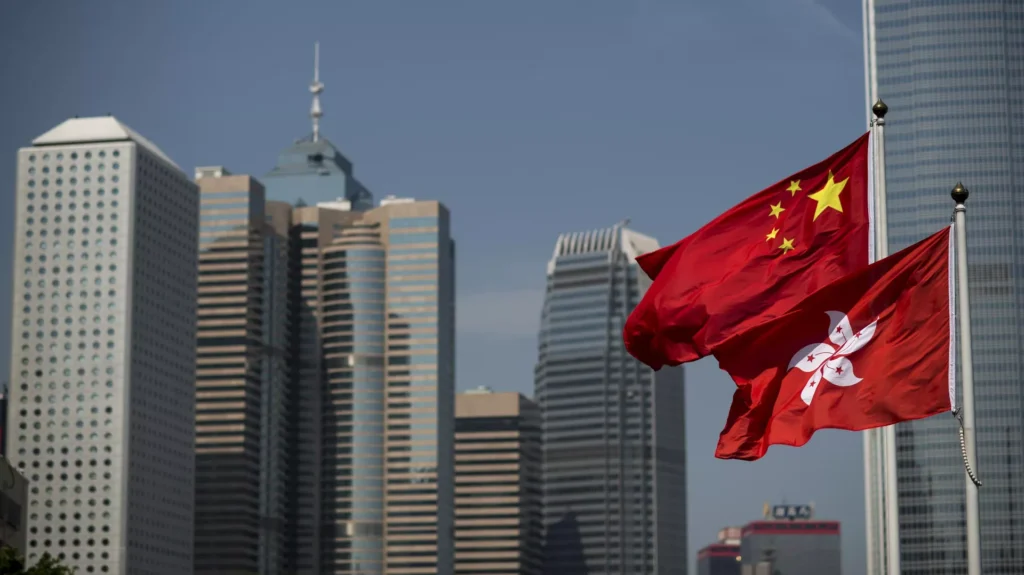China Designs an Economic Road Map All the Way to 2029
BRICS, 29 Jul 2024
Pepe Escobar | Sputnik – TRANSCEND Media Service
There can hardly be a better place to track the four-day, twice-a-decade plenum of the Communist Party of China than dynamic, “one country, two systems” Hong Kong.
22 Jul 2024 – Hong Kong is right at the heart of East Asia – halfway between Northeast Asia (Japan, the Koreas) and Southeast Asia. To the west is not only China but the Eurasia landmass, linking it to India, Persia, Turkiye and Europe. To the east, sailing forward, is the Pacific and the US’s West Coast.
Moreover, Hong Kong is the ultimate multipolar, multi-nodal (italics mine) hub: a frenzied global metropolis forged by trade routes going back centuries, attracting people from every latitude keen on interconnecting commerce, ideas, technologies, shipping, commodities, markets.
Now, reinvented for 21stcentury Eurasia integration, Hong Kong has all it takes to profit as a key node of the Greater Bay Area, the southern hub propelling China to economic superpower status.
The plenum in Beijing was a quite serious/sober affair – trying to strike a balance between sustainable economic growth and national security all the way to 2029, when the PRC celebrates its 80th anniversary.
The proverbial comprador elites, 5th columnists and outright Sinophobes across the West have gone bonkers on the current slowdown of the Chinese economy – complete with slumps in the financial and property fronts – running in parallel to all hybrid war strands of Chinese containment emanating from Washington.
Fact: China’s GDP grew roughly 5% in the first semester; and the final plenum communique, released at the end of the four-day meeting, stressed that this should remain the “unwavering” target for the second semester.
The official rhetoric of course was heavy on stimulation of domestic consumption, and “new momentum” to drive exports and imports.
This key passage in the final communique breaks it all down when it comes to the new iteration of “socialism with Chinese characteristics”:
“We must purposefully give more prominence to reform and further deepen reform comprehensively with a view to advancing Chinese modernization in order to better deal with the complex developments both at home and abroad, adapt to the new round of scientific and technological revolution and industrial transformation, and live up to the new expectations of our people.
It was stressed that, to further deepen reform comprehensively, we must stay committed to Marxism-Leninism, Mao Zedong Thought, Deng Xiaoping Theory, the Theory of Three Represents, and the Scientific Outlook on Development and fully implement Xi Jinping Thought on Socialism with Chinese Characteristics for a New Era.
We must thoroughly study and implement General Secretary Xi Jinping’s new ideas, viewpoints, and conclusions on comprehensively deepening reform and fully and faithfully apply the new development philosophy on all fronts.”
And to make it more simple, Xi actually explained it all in some detail.
Those Pesky ‘Markets’
Nowhere around the world one finds a government focused on devising five-year plans for economic development (Russia now seems to be engaged in its first attempts) – encompassing development of rural land, tax reform, environmental protection, national security, the fight against corruption, and cultural development.
When the term “reform” appears no less than 53 times in the final communique, that means – contrary to Western proselytism – that the CPC is dead set on improving governance and increasing efficiency. And all those targets must be met – otherwise heads will roll.
Science and technology will once again have pride of place in China’s development, a sort of follow-up to the Made in China 2025 strategy. The emphasis predictably will be on better integration of the digital economy into the real economy; infrastructure upgrading; and boosting “resilience” in the industrial supply chain.
It’s fascinating to watch how the communique emphasizes the necessity to “correct market failures” – which is a euphemism for reigning in turbo-neoliberalism. What is stressed is “unswerving support and guidance” to the development of the “non-state sector”, with Beijing ensuring “all forms of ownership” in the economy competing fairly and lawfully “on an equal footing”.
The plenum could be easily interpreted as a calculated exercise in Taoist patience. According to Xie Maosong, from the China Institute for Innovation and Development Strategy at the Chinese Academy of Sciences, “Xi said many times that the easy part of the reform is over, and now we are in uncharted waters. The party must watch its step, particularly as the external risks build. We are also touching the vested interests of many groups.”
Of course turbo-capitalist Hong Kong’s main obsession is “markets”. Conversations with British traders scouting Asia for their clients reveal they are not so keen on investing in China – yet that does not faze Beijing’s planners. What matters for the Politburo is how to meet the economic, social, environmental and geopolitical targets set by Xi for the next five years. It’s up to the markets to adapt to it.
Of course Beijing planners are already factoring Trump in the overall equation. The Western mantra that China’s economy is struggling to stabilize may be debatable. Yet China’s economy may be in fact in a more precarious position now than when Trump unleashed his trade war in mid-2018. The yuan may seem to be under more pressure because of the gap between US and Chinese borrowing costs.
According to a JPMorgan estimate, every 1% tariff hike during the 2018-2019 period of the US-launched trade war was linked to a 0.7% rise of the US dollar versus the yuan.
Trump plans to impose a 60% tariff on virtually all Chinese products. That would lead to an exchange rate of roughly 9 yuan to the dollar, 25% weaker than now.
Now Read the Whole Thing and Get to Work
It’s enlightening to check what Hong Kong’s chief executive, John Lee, said about the plenum. He encouraged “all sectors of the community” to read the communique. And the Hong Kong business elite did get the drift: they interpreted it as Beijing betting once again on Hong Kong’s key role for the development of the Greater Bay Area.
It would not be any other way. Hong Kong, Lee stressed, is a “superconnector” and “super value-adder”, linking mainland China with the Global North and the Global South, and still attracting all sorts of foreign investment to China.
Now compare it with the predominant view on Hong Kong in US business circles. The American Chamber of Commerce in Hong Kong is appalled, stressing how US businessmen in fact don’t understand the Safeguarding National Security directive approved last March, which complemented the National Security Law installed by Beijing in 2020.
For Beijing, these are very serious matters of national security – which range from a crackdown on money laundering to preventing the proverbial 5th columnists from launching a color revolution such as the one that nearly destroyed Hong Kong in 2019. No wonder so many American investors cannot get it. Beijing couldn’t care less.
Now let’s see what China’s top mutual fund manager has to say about it.
Zhang Kun, manager of Blue Chip Mixed Fund, runs four funds with combined assets of $8.9 billion. He prefers to set his sights on Beijing’s aim to boost per capita GDP to match the West by 2035.
If that happens, with or without a US trade war – and the Chinese won’t stop at nothing to achieve it – then per capita GDP could be around $ 30,000 (it was $12,300 last year, according to Chinese think tanks).
So foreign investment will continue to be welcomed in China, via Hong Kong or not. But on each and every front, what trumps everything is national security. Call it a practical exercise in sovereignty.
_______________________________________________
 Pepe Escobar, born in Brazil, is a correspondent and editor-at-large at Asia Times and columnist for Consortium News and Strategic Culture in Moscow. Since the mid-1980s he’s lived and worked as a foreign correspondent in London, Paris, Milan, Los Angeles, Singapore, and Bangkok. He has extensively covered Pakistan, Afghanistan and Central Asia to China, Iran, Iraq and the wider Middle East. He is the author of Globalistan (2007), Red Zone Blues (2007), Obama Does Globalistan (2009), Empire of Chaos (2014) and 2030 (2015), all by Nimble Books. Pepe was contributing editor to The Empire and The Crescent and Tutto in Vendita in Italy and is also associated with the Paris-based European Academy of Geopolitics. When not on the road he lives between Paris and Bangkok.
Pepe Escobar, born in Brazil, is a correspondent and editor-at-large at Asia Times and columnist for Consortium News and Strategic Culture in Moscow. Since the mid-1980s he’s lived and worked as a foreign correspondent in London, Paris, Milan, Los Angeles, Singapore, and Bangkok. He has extensively covered Pakistan, Afghanistan and Central Asia to China, Iran, Iraq and the wider Middle East. He is the author of Globalistan (2007), Red Zone Blues (2007), Obama Does Globalistan (2009), Empire of Chaos (2014) and 2030 (2015), all by Nimble Books. Pepe was contributing editor to The Empire and The Crescent and Tutto in Vendita in Italy and is also associated with the Paris-based European Academy of Geopolitics. When not on the road he lives between Paris and Bangkok.
Go to Original – sputnikglobe.com
Tags: BRICS, China, Development, Economics, Hong Kong
DISCLAIMER: The statements, views and opinions expressed in pieces republished here are solely those of the authors and do not necessarily represent those of TMS. In accordance with title 17 U.S.C. section 107, this material is distributed without profit to those who have expressed a prior interest in receiving the included information for research and educational purposes. TMS has no affiliation whatsoever with the originator of this article nor is TMS endorsed or sponsored by the originator. “GO TO ORIGINAL” links are provided as a convenience to our readers and allow for verification of authenticity. However, as originating pages are often updated by their originating host sites, the versions posted may not match the versions our readers view when clicking the “GO TO ORIGINAL” links. This site contains copyrighted material the use of which has not always been specifically authorized by the copyright owner. We are making such material available in our efforts to advance understanding of environmental, political, human rights, economic, democracy, scientific, and social justice issues, etc. We believe this constitutes a ‘fair use’ of any such copyrighted material as provided for in section 107 of the US Copyright Law. In accordance with Title 17 U.S.C. Section 107, the material on this site is distributed without profit to those who have expressed a prior interest in receiving the included information for research and educational purposes. For more information go to: http://www.law.cornell.edu/uscode/17/107.shtml. If you wish to use copyrighted material from this site for purposes of your own that go beyond ‘fair use’, you must obtain permission from the copyright owner.
Join the discussion!
We welcome debate and dissent, but personal — ad hominem — attacks (on authors, other users or any individual), abuse and defamatory language will not be tolerated. Nor will we tolerate attempts to deliberately disrupt discussions. We aim to maintain an inviting space to focus on intelligent interactions and debates.
